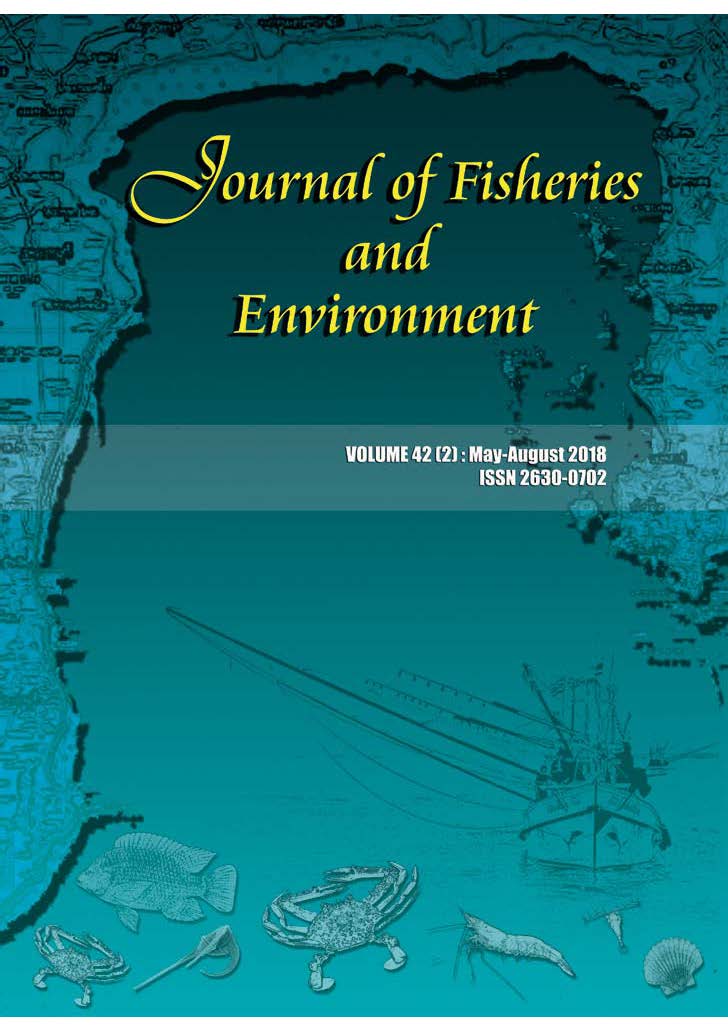Effects of Genetics and Rearing Environments on Morphometric Variation in Hatchery Stocks of Asian Sea Bass, Lates calcarifer (Bloch, 1790)
Main Article Content
Abstract
The effects of genetics and rearing environments on morphometric variation among hatchery stocks of Asian sea bass (300 days post-hatch) were investigated by multivariate analyses of 21 truss measurements. Ninety-day-old fingerlings from four stocks, including Ang Sila, Bang Pakong, Meklong and Paknam, were stocked in the same earthen pond and reared for 270 days. These stocks were genetically different from each other. Principal component analysis (PCA) of body measurements suggested very little body shape difference among populations. Subsequently, discriminant function analysis (DFA) was used to assign individuals to their stock of origin. The accuracy of assignment was highest for the Ang Sila stock (77.7%) followed by Bang Pakong (72.4%), Meklong (66.1%) and Pak Nam (65.5%). Analysis of the Ang Sila stock reared in two locations, Chantaburi and Prachuab Kirikhan provinces, suggested that salinity is an important factor affecting body shape differentiation. DFA identified the two most discriminating truss measures, both of which were correlated with head size. The classification functions assigned individuals to groups with 100% accuracy. The results demonstrated that multivariate morphometrics is an effective tool for detecting variation among stocks in Asian sea bass aquaculture.
Article Details
References
2. Bookstein, F.L., B. Chernoff, R.L. Elder, J.M. Humphries, G.R. Smith and R.E. Strauss. 1985. Morphometrics in Evolutionary Biology: The Geometry of Size and Shape Change, with Examples from Fishes. The Academy of Natural Sciences of Philadelphia. Philadelphia, PA, USA.
3. Bosworth, B.G., G. Libey and D.R. Notter. 1998. Relationships among total weight, body shape, visceral components, and fillet traits in palmetto bass (striped bass female Morone saxatilis × white bass male M. chrysops) and paradise bass (striped bass female M. saxatilis × yellow bass male M. mississippiensis). Journal of the World Aquaculture Society 29: 40-50.
4. Cibert, C., Y. Fermon, D. Vallod, and F.J. Meunier. 1999. Morphological screening of carp Cyprinus carpio: relationship between morphology and fillet yield. Aquatic Living Resources 12: 1 – 10.
5. Corti, M., R.S. Thorpe, L. Sola, V. Sbordoni and S. Cataudella, S. 1988. Multivariate morphometrics in aquacultire: A case study of six stocks of the common carp (Cyprinus carpio) from Italy. Canadian Journal of Fisheries and Aquatic Sciences 45: 1548−1554.
6. Eknath, A.E., J.M. Macaranas, L.Q. Agustin, R.R. Velasco, M.C.A. Ablan, M.J.R. Pante and R.S.V. Pullin. 1991. Biochemical and morphometric approaches to characterize farmed tilapias. ICLARM Quarterly no. 722. pp. 7−9.
7. Elliott N.G., K. Haskard and J.A. Koslow. 1995. Morphometric analysis of orange roughy (Hoplostethus atlanticus) off the continental slope of southern Australia. Journal of Fish Biology 46: 202-220.
8. Fitzgerald, D.G., J.F. Nanson, T.M. Todd and B.M. Davis. 2002. Application of truss analysis for the quantification of changes in fish condition. Journal of Aquatic Ecosystem Stress and Recovery 9: 115–125.
9. Food and Agriculture Organization, United Nations. 2017. Fishstat Plus Version 2.30. FAO Fisheries Department, Fishery Information, Data and Statistics Unit. https://www.fao.org./fi/statist/FISOFT/FISHPLUS asp, December 20, 2017.
10. Hammer, O., D.A.T. Harper and P.D. Ryan. 2015. Reference Manual: Past Paleontological Statistics Version 3.08. Natural History Museum, University of Oslo.
11. Husemann, M., M. Tobler, C. McCauley, B. Ding and P.D. Danley. 2017. Body shape differences in a pair of closely related Malawi cichlids and their hybrids: Effects of genetic variation, phenotypic plasticity, and transgressive segregation. Ecology and Evolution 7: 4336–4346
12. Joerakate, W., S.Yenmak, W. Senanan, S. Tunkijjanukij, S. Koonawootrittriron and S. Poompuang. Growth performance and genetic diversity in four strains of Asian sea bass, Lates calcarifer (Bloch, 1790) cultivated in Thailand. Agriculture and Natural Resources (In press).
13. Kungvankij, P., B.J. Pudadera Jr., L.B.Tiro and I.O. Potestas. 1984. Biology and Culture of Sea Bass (Lates calcarifer), NACA Training Manual Series No 3.
14. Meyer A. 1990. Morphometrics and allometry in the trophically polymorphic cichlid fish, Cichlasoma citrinellum: alternative adaptations and ontogenetic changes in shape. Journal of Zoology 221: 237-260.
15. Pannusa, S., S. Poompuang and W. Kamonrat. 2015. Genetic and morphological variation among hatchery stocks of Thai silver barb Barbonymus gonionotus (Bleeker, 1850). Kasetsart Journal (Natural Science) 49: 856 – 867.
16. Partridge, G.J., and A.J. Lymbery. 2008. The effect of salinity on the requirement for potassium by barramundi (Lates calcarifer) in saline groundwater. Aquaculture 278: 164-170.
17. Senanan, W., J. Pechsiri, S. Sonkaew, U. Na-Nakorn, N. Sean-In and R. Yashiro. 2015. Genetic relatedness and differentiation of hatchery populations of Asian seabass (Lates calcarifer) (Bloch, 1790) broodstock in Thailand inferred from microsatellite genetic markers. Aquaculture Research 46: 2897-2912.
18. Siddik, M.A.B, A. Hanif, R. Chaklader, A. Nahar and R. Fotedar. 2016. A multivariate morphometric investigation to delineate stock structure of gangetic whiting, Sillaginopsis panijus (Teleostei: Sillaginidae). SpringerPlus 5: 520.
19. Strange, R.J. 1996. Field examination of fishes. In: Fisheries Techniques, second edition (eds. B.R. Murphy and D.W. Willis), pp. 433-482. American Fisheries Society, Bethesda, MD, USA.
20. Wimberger, P. H. 1992. Plasticity of fish body shape. The effects of diet, development, family and age in two species of Geophagus (Pisces: Cichlidae). Biological Journal of the Linnean Society 45: 197-218.
21. Winans, G. A. 1984. Multivariate morphometric variability in Pacific salmon: Technical demonstration. Canadian Journal of Fisheries and Aquatic Sciences 41: 1150−1159.
22. Zhang C, Y. Q. Jiang, T. Z. Ye, Z. G. Li and S.Z. Dou. 2016. A morphometric investigation of the small yellow croaker (Larimichthys polyactis Bleeker, 1877): evidence for subpopulations on the Chinese coast. Journal of Applied Ichthyology 32: 67–74.


